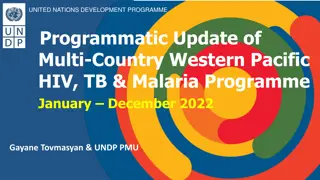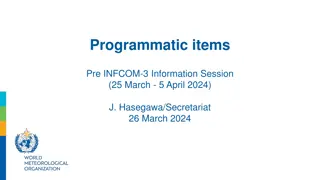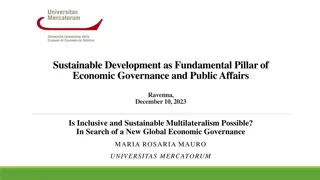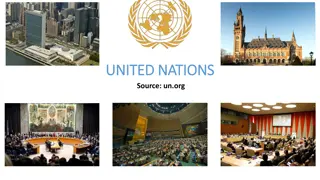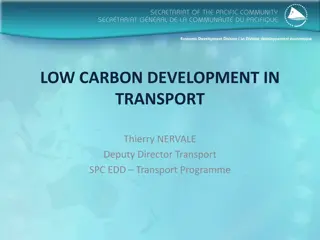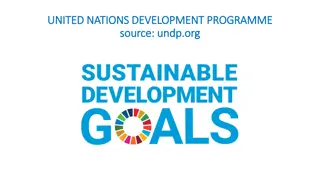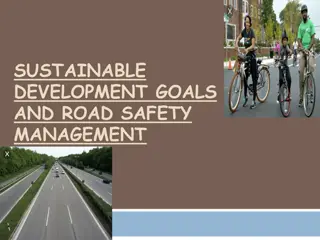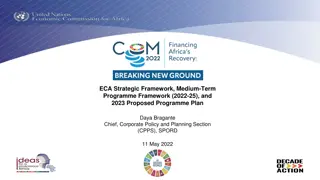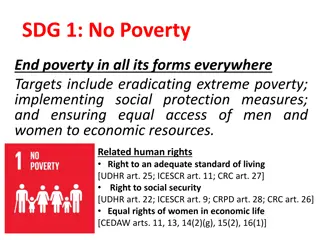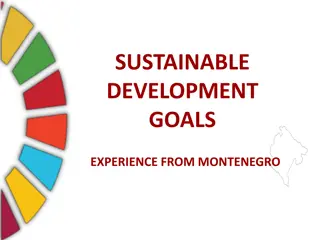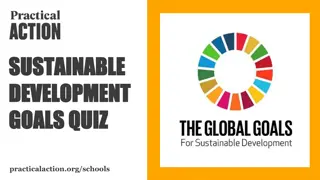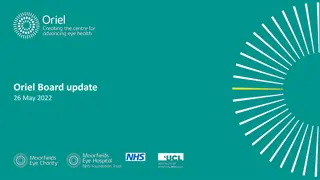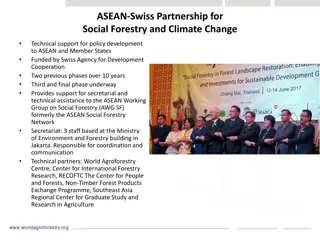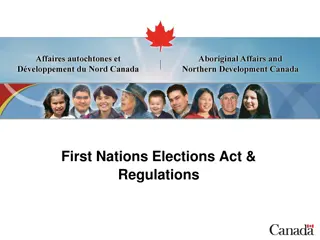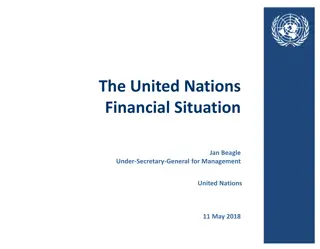United Nations Development Programme: Helping Nations Achieve Sustainable Growth
The United Nations Development Programme (UNDP) is a key organization dedicated to aiding countries in eradicating poverty and fostering sustainable economic growth and human development. Established in 1966, UNDP provides support to developing nations, emphasizing assistance to the least developed countries. Through initiatives such as the Millennium Development Goals, UNDP aims to combat global challenges like extreme poverty, hunger, inadequate education, gender inequality, child mortality, maternal health, and diseases. By focusing on human and natural resources development, UNDP plays a vital role in promoting global partnership for development and ensuring environmental sustainability.
Download Presentation

Please find below an Image/Link to download the presentation.
The content on the website is provided AS IS for your information and personal use only. It may not be sold, licensed, or shared on other websites without obtaining consent from the author.If you encounter any issues during the download, it is possible that the publisher has removed the file from their server.
You are allowed to download the files provided on this website for personal or commercial use, subject to the condition that they are used lawfully. All files are the property of their respective owners.
The content on the website is provided AS IS for your information and personal use only. It may not be sold, licensed, or shared on other websites without obtaining consent from the author.
E N D
Presentation Transcript
UNDP UNITED NATIONS DEVELOPMENT PROGRAMME
INRODUCTION The United Nations Development Programme (UNDP) is a United Nations organization tasked with helping countries eliminate povertyand achieve sustainable economic growth and human development. Headquartered in New York City, it is the largest UN development aid agency, with offices in 170 countries. UNDP also encourages the protection of human rights and empowerment of women in all of its programs the UNDP human development report office also published and annual human development report since 1992 method and analyze developmental progress.
HISTORY UNDP is based on the merging of the United Nations Expanded Programme of Technical Assistance, created in 1949, and the United Nations Special Fund, established in 1958. UNDP, as we know it now, was established in 1966 by the General Assembly of the United Nations.
AIM The basic objective of UNDP is to help poorer nations develop their human and natural resources more fully. To provides expert advice, training, and grant support to developing countries, with increasing emphasis on assistance to the least developed countries.
THE MILLINNIUM DEVELOPMENT GOALS Eradicate extreme poverty and hunger Achieve universal primary education Promote gender equality and empower women Reduce child mortality Improve maternal health Combat HIV/AIDS, malaria and other diseases Ensure environmental sustainability Develop a global partnership for development
ERADICATE EXTREME POVERTY AND HUNGER About 700 million people live in conditions of extreme poverty in 2010 than in 1990. The economic and financial crisis has widened the global jobs gap for 67 million people. One in eight people still go to bed hungry, despite major progress. Globally nearly one in six children under age 5 are underweight; 1 in 4 are stunted An estimated 7% of children under age 5 worldwide are now overweight, another aspect of malnutrition; one quarter of these children live in sub- Saharan Africa.
ACHIEVE UNIVERSAL PRIMARY EDUCATION In 2011, 57 million children of primary school age were out of school, down from 102 million in 2000. More than half of these out of school children live in sub Saharan Africa. Globally, 1 2 3 million youth (aged 15 to 24) reading and writing skills; 61% of them are young women.
PROMOTE GENDER EQUALITY AND EMPOWER WOMEN Gender parity is closest to being achieved at the primary level; however, only 2 out of 130countries have achieved that target at all level of education. Globally 40 out of 100 wage-earning jobs in the non-agricultural sector are held by women. As a 31 January 2013, the average shareof women members in parliament worldwide was just what 20%.
REDUCE CHILD MORTALITY Big gains have been made in child survival, but efforts must be redoubled to meet the global target. The target is to reduce by two-thirds between 1990 and 2015, the under five years old mortality rate, from 93 children of every 1,000 dying of every 1000.
IMPROVE MATERNAL HEALTH In eastern Asia, Northern Africa and South Asia, maternal mortality has declined by around two-thirds. Only half a pregnant women in developing regions receive the recommended minimum of 4 antenatal care visits. Some 140 million women worldwide who are married or in union say they would like to delay or avoid pregnancy, but are not using contraception
COMBAT HIV/AIDS, MALARIA AND OTHER DISEASES In 2011, 230,000 fewer children under age 15 were infected with HIV than in 2001. 8 million people were receiving antiretroviral therapy for HIV at the end of 2011. In the decent since 2000, 1.1 million deaths from malaria were averted. Treatment for tuberculosis have saved some 20 million lives between 1995 and 2011.
ENSURE ENVIRONMENTAL SUSTAINABILITY Global emissions of carbon dioxide have increased by more than 46% since 1990. Nearly one third of marine fish stocks have been overexploited. Many species at risk of extinction, despite an increase in protected areas. More than 2.1 billion people and almost 1.9 billion people, respectively, have gained access to improved water sources and sanitation facilities and 1990. An estimated 863 million people reside in slums in the developing world.
DEVELOP A GLOBAL PARTNERSHIP FOR DEVELOPMENT There is less aid money overall, with the poorest countries most adversely affected.
MEMBERSHIP All the nations of the world, both rich and poor are the members in the UNDPP. The nations meet annually and pledge contributions to the UNDP. India is a member in the UNDP.
FUNCTIONS Democratic Governance Poverty Reduction Crisis Prevention and Recovery Environment And Energy
DEMOCRATIC GOVERNANCE Providing policy advice and technical support. Sharing successful experiences Educating populations Increasing institutional and individual capacity with countries
POVERTY REDUCTION Linking poverty programs with countries larger goals and policies Ensuring a greater voice for the poor Foreign investment, and ensure the poorest of the poor benefit from globalization
ACTIVITY AND FUNCTIONS It works in collaboration with all other international health agencies. The UNDP projects cover virtually every economic and social sector- agriculture, industry, education and science, health, social welfare etc. UNDP supports research and cooperative activities to combat health problem threatening socio economic development. To accomplish the MDGs and encourage global development, UNDP focuses on poverty reduction, HIV/AIDS, democratic governance, energy and environment, social development, and crisis prevention and recovery.
UNDP also encourages a protection of human rights and the empowerment of women in all of its programs. The UNDP Human Development Report Office also publishes an annual Human Development Report (since 1990) to measure and analyze development and progress. In addition to a global report, UNDP publishes regional, National, and local Human Development Reports. UNDP is funded entirely by voluntary contributions for member Nations.
The organization operates in 177 countries, where it works with local governments to me development challenges and developed local capacity. Additionally the UNDP works internationally to help countries achieve the Millennium Development Goals (MDGs). Currently, the UNDP is one of the main UN agencies involved in the development of the post-2015 Development Agenda. UNDP works with Nations on their own solutions to global and national development challenges. At the develop local capacity, they draw on the people of UNDP and its wide range of partners.
UNDP IN INDIA UNDP has worked in india since 1951 in almost all areas of - Human development - From systems and institutional strengthening to inclusive growth and sustainable livelihoods, - Sustainable energy, - Environment, - Helping to achieve the eradication to poverty, - The reduction of inequalities and exclusion.
Locations Guwahati Assam (for the North East) Chandigarh, Haryana Bhopal, Madhya Pradesh Mumbai, Maharashtra New Delhi Ranchi, Jharkhand
REFERENCES Park s textbook of Preventive and social medicine (23th Edition) Dijkzeul D. The united nations Development Programme: The Development of peace? International peacekeeping 1998; 5(4):92-119. www.undp.org


